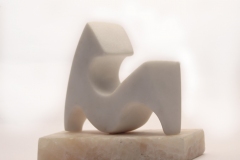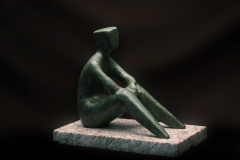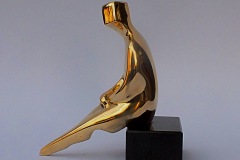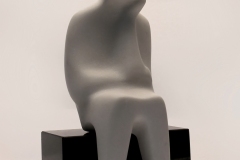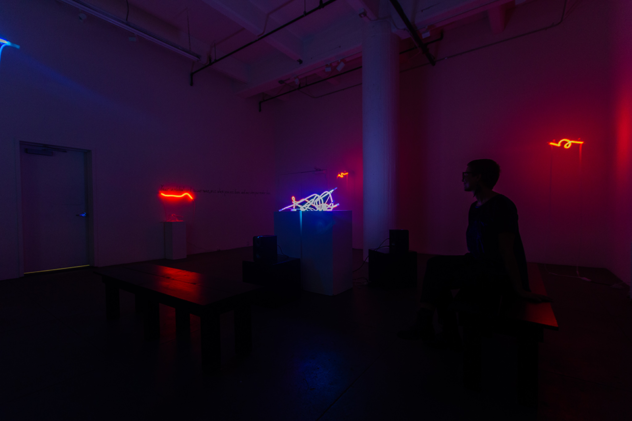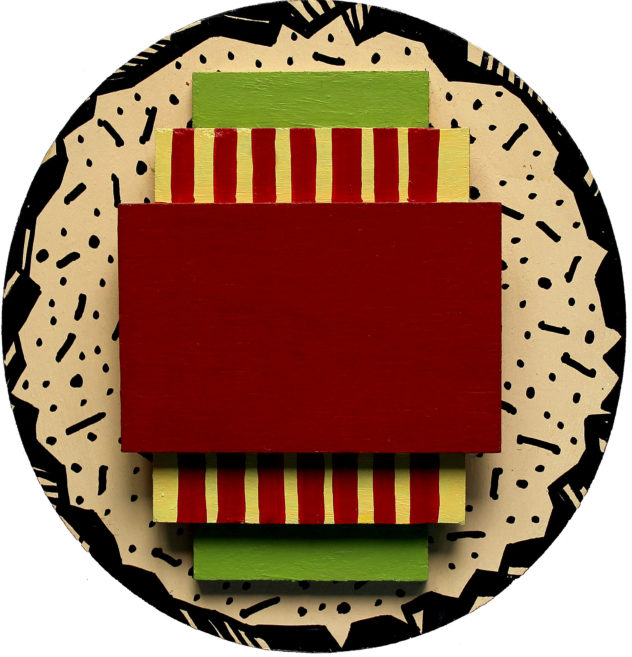A Palm as a Measure – Nikola Smilkov’s Figurines
The extraordinary tactility of figurines that can almost fit into the palm of one hand, their dimensions and the subtle processing of stone in the latest cycle of Nikola Smilkov reveal the idea of something extremely subtle and fragile, preserved as something precious; but, at the same time, a very suggestive impression of monumentality has been achieved by using wide and clean surfaces.
Although unusually small in size, only ten to fifteen centimeters, the figurines are pondered and shaped as monumental sculptures, without meticulous processing and redundant details that would draw attention away from the whole. Clear and skillfully defined lines of mass have achieved exceptional ease not only of the movement, but also of the shape in its entirety, although it is mostly about the stone material. The manner of material processing has achieved the state of body sensuality, without the literal representation of recognizable attributes of nudity. Everything is reduced to the masses and the state of softness of the surface itself, i.e. of the texture of the stone material. By skillfully reducing the shapes in the spirit of Cubism, but without the depersonalization which is often present in Cubist figures, the artist “transfuses” the idea of the female being’s subtlety into stone in a very sensitive way. The softness of the flesh, the warmth of touch, the gentleness of the female body – they are all preserved in figurines shaped in stone … Although there is a noticeable Cubist reduction in shape, there are no sharp edges; by the very way of processing the stone everything is softened, with soft contours and in the sign of gentleness and confluence of masses. Everything “flows” softly, both lines and masses, so the figurines have a distinct visual effect of sophistication and subtlety.
***
The artist opposes the firmness, the cold luster and sharpness of the contours of the black granite to the velvetyness of the surface, the gentleness of the contours and the luminous whiteness of the marble thus emphasizing the essential properties of the gentleness and fragility of the female being.
On figurines in metal (bronze) a tougher modeling is observed; shapes are stricter; the principle of cubic reduction to basic geometric shapes is present to a greater extent, especially in the treatment of the head. The emphasis is more on the relation of mass and shape, and less on the fleshliness of the naked body, which is largely conditioned by the possibilities of the material itself. Being well aware of the possibilities of expression of the material, Smilkov uses bronze as a material in which the sharpness and slimness of the shape can be most clearly achieved, as well as the “soundness” of the material itself. By placing bronze figurines on a stone base, the artist measures the ratio of bronze and stone, opposing the two states and levels of the visual effect of the surface’s luster, but also the sonorousness of bronze – to the muffledness of stone.
***
Finally, it can be said that the latest cycle of Nikola Smilkov’s figurines on the theme of the human body reveals the artist’s extremely nurtured sensitivity to the material’s expression. It is precisely the respect of the nature of the material that has essentially determined the modern sculpture at the beginning of the 20th century, which enabled a crucial shift in relation to the European sculpture of the last few centuries that “suffocated” in details in the representation of figures, which frequently annulled one of the essential characteristics of sculptural work, that is, above all, the expression of the material.
The significance and the radical change that brought about a new approach to the material in modern sculpture are testified by artists’ superlative works, most prominent in the tendencies of respecting nature and possibilities of expression of the material itself, specifically in stone – primarily all the works of Constantin Brâncuşi at the very beginning of the 20th century, but also by Isamu Noguchi, Vojin Bakić and others during the second half of the 20th century; and, in the domain of bronze, i.e. metal – Alberto Giacometti, Henry Moore, Julio Gonzalez and others; and today, at the beginning of the 21st century, especially the works of Richard Serra. The basic guideline in Nikola Smilkov’s works has been so far precisely on that line of seeking and finding the possibility of expressing the essential properties of materials, primarily stone, but also of bronze.
By exhibiting several of the most successful works of this cycle in a public space of monumental proportions, first of all, the sculptures Awakening (2015) and Anticipation (2015), in the well-established relationship of the sculpture itself with the surrounding space, the very essence of the female being would be “immortalized” in a modern but also timeless manner, and their full expression would be realized.
Rajka Boskovic PhD
Art Historian and Theoretician


